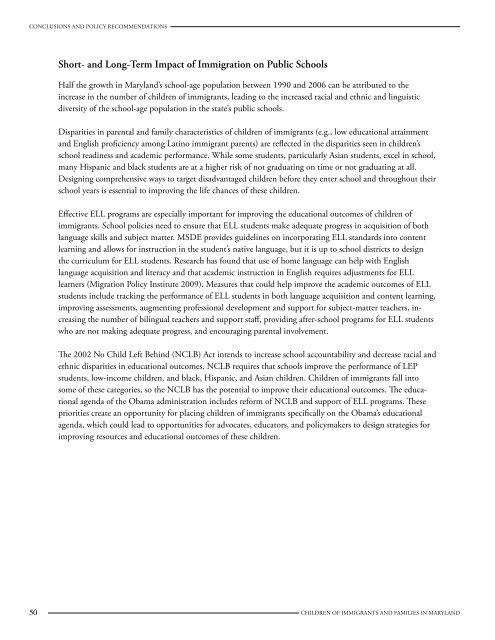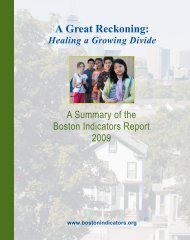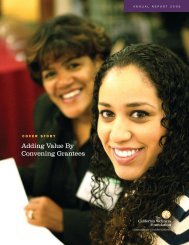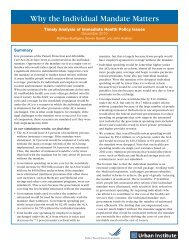The Integration of Immigrants and Their Families in Maryland: A ...
The Integration of Immigrants and Their Families in Maryland: A ...
The Integration of Immigrants and Their Families in Maryland: A ...
Create successful ePaper yourself
Turn your PDF publications into a flip-book with our unique Google optimized e-Paper software.
Conclusions <strong>and</strong> Policy RecommendationsShort- <strong>and</strong> Long-Term Impact <strong>of</strong> Immigration on Public SchoolsHalf the growth <strong>in</strong> Maryl<strong>and</strong>’s school-age population between 1990 <strong>and</strong> 2006 can be attributed to the<strong>in</strong>crease <strong>in</strong> the number <strong>of</strong> children <strong>of</strong> immigrants, lead<strong>in</strong>g to the <strong>in</strong>creased racial <strong>and</strong> ethnic <strong>and</strong> l<strong>in</strong>guisticdiversity <strong>of</strong> the school-age population <strong>in</strong> the state’s public schools.Disparities <strong>in</strong> parental <strong>and</strong> family characteristics <strong>of</strong> children <strong>of</strong> immigrants (e.g., low educational atta<strong>in</strong>ment<strong>and</strong> English pr<strong>of</strong>iciency among Lat<strong>in</strong>o immigrant parents) are reflected <strong>in</strong> the disparities seen <strong>in</strong> children’sschool read<strong>in</strong>ess <strong>and</strong> academic performance. While some students, particularly Asian students, excel <strong>in</strong> school,many Hispanic <strong>and</strong> black students are at a higher risk <strong>of</strong> not graduat<strong>in</strong>g on time or not graduat<strong>in</strong>g at all.Design<strong>in</strong>g comprehensive ways to target disadvantaged children before they enter school <strong>and</strong> throughout theirschool years is essential to improv<strong>in</strong>g the life chances <strong>of</strong> these children.Effective ELL programs are especially important for improv<strong>in</strong>g the educational outcomes <strong>of</strong> children <strong>of</strong>immigrants. School policies need to ensure that ELL students make adequate progress <strong>in</strong> acquisition <strong>of</strong> bothlanguage skills <strong>and</strong> subject matter. MSDE provides guidel<strong>in</strong>es on <strong>in</strong>corporat<strong>in</strong>g ELL st<strong>and</strong>ards <strong>in</strong>to contentlearn<strong>in</strong>g <strong>and</strong> allows for <strong>in</strong>struction <strong>in</strong> the student’s native language, but it is up to school districts to designthe curriculum for ELL students. Research has found that use <strong>of</strong> home language can help with Englishlanguage acquisition <strong>and</strong> literacy <strong>and</strong> that academic <strong>in</strong>struction <strong>in</strong> English requires adjustments for ELLlearners (Migration Policy Institute 2009). Measures that could help improve the academic outcomes <strong>of</strong> ELLstudents <strong>in</strong>clude track<strong>in</strong>g the performance <strong>of</strong> ELL students <strong>in</strong> both language acquisition <strong>and</strong> content learn<strong>in</strong>g,improv<strong>in</strong>g assessments, augment<strong>in</strong>g pr<strong>of</strong>essional development <strong>and</strong> support for subject-matter teachers, <strong>in</strong>creas<strong>in</strong>gthe number <strong>of</strong> bil<strong>in</strong>gual teachers <strong>and</strong> support staff, provid<strong>in</strong>g after-school programs for ELL studentswho are not mak<strong>in</strong>g adequate progress, <strong>and</strong> encourag<strong>in</strong>g parental <strong>in</strong>volvement.<strong>The</strong> 2002 No Child Left Beh<strong>in</strong>d (NCLB) Act <strong>in</strong>tends to <strong>in</strong>crease school accountability <strong>and</strong> decrease racial <strong>and</strong>ethnic disparities <strong>in</strong> educational outcomes. NCLB requires that schools improve the performance <strong>of</strong> LEPstudents, low-<strong>in</strong>come children, <strong>and</strong> black, Hispanic, <strong>and</strong> Asian children. Children <strong>of</strong> immigrants fall <strong>in</strong>tosome <strong>of</strong> these categories, so the NCLB has the potential to improve their educational outcomes. <strong>The</strong> educationalagenda <strong>of</strong> the Obama adm<strong>in</strong>istration <strong>in</strong>cludes reform <strong>of</strong> NCLB <strong>and</strong> support <strong>of</strong> ELL programs. <strong>The</strong>sepriorities create an opportunity for plac<strong>in</strong>g children <strong>of</strong> immigrants specifically on the Obama’s educationalagenda, which could lead to opportunities for advocates, educators, <strong>and</strong> policymakers to design strategies forimprov<strong>in</strong>g resources <strong>and</strong> educational outcomes <strong>of</strong> these children.50Children <strong>of</strong> <strong>Immigrants</strong> <strong>and</strong> <strong>Families</strong> <strong>in</strong> Maryl<strong>and</strong>
















